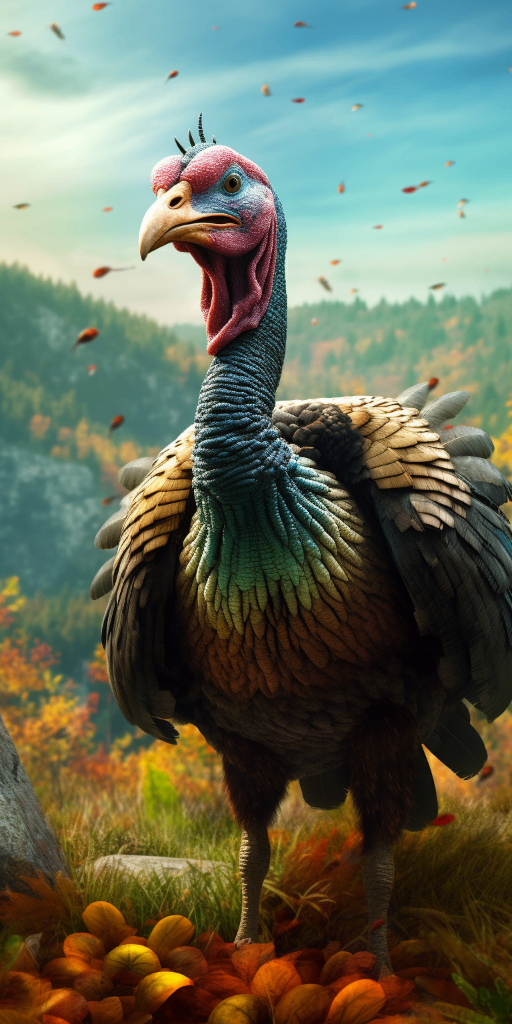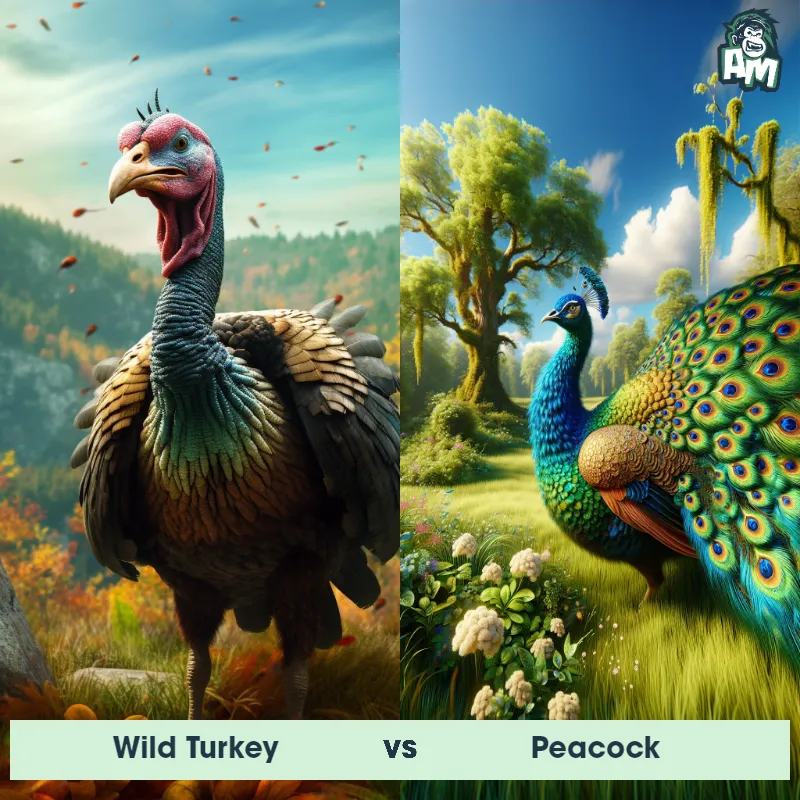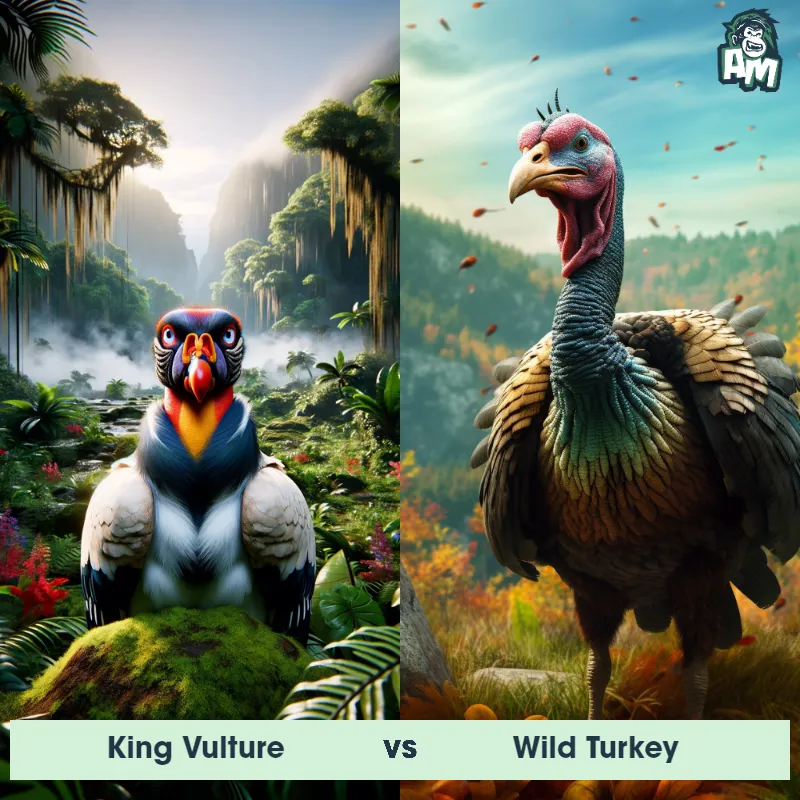The Wild Turkey
The Wild Turkey, scientifically known as Meleagris gallopavo, is a large and stocky bird native to North America. It can reach up to 4 feet tall and has a wingspan of up to 5 feet. The males, known as toms, are larger than the females, called hens, and are adorned with bright iridescent feathers in shades of bronze, copper, and green. They also have a fleshy, wattle-like structure called a snood that hangs from their forehead, which can change in size and color depending on their mood and dominance. Wild Turkeys have sharp beaks, strong legs, and powerful wings that allow them to run fast, fly short distances, and perch on trees.

| Wild Turkey | |
|---|---|
| Size | Up to 4 feet (1.2 meters) in length |
| Weight | Up to 25 pounds (11.3 kilograms) |
| Speed | Speed: 25 mph (40.23 km/hr) |
| Key Strength | Sharp spurs on legs |
| Biggest Weakness | Limited mobility due to size |
| Scientific Name | Meleagris gallopavo |
| Family | Phasianidae |
| Habitat | Forests, woodlands, and grasslands |
| Geography | North America |
| Diet | Omnivorous, feeds on insects, seeds, and small mammals |
| Lifespan | 3 years - 5 years |

The Wild Turkey
The Wild Turkey, scientifically known as Meleagris gallopavo, is a large and stocky bird native to North America. It can reach up to 4 feet tall and has a wingspan of up to 5 feet. The males, known as toms, are larger than the females, called hens, and are adorned with bright iridescent feathers in shades of bronze, copper, and green. They also have a fleshy, wattle-like structure called a snood that hangs from their forehead, which can change in size and color depending on their mood and dominance. Wild Turkeys have sharp beaks, strong legs, and powerful wings that allow them to run fast, fly short distances, and perch on trees.
Fun Fact: Wild Turkeys have an impressive ability to adapt and thrive in various habitats, from forests and woodlands to grasslands and marshes. They are highly adaptable and can be found in almost every state in the United States, except Alaska.
| Wild Turkey | |
|---|---|
| Size | Up to 4 feet (1.2 meters) in length |
| Weight | Up to 25 pounds (11.3 kilograms) |
| Speed | Speed: 25 mph (40.23 km/hr) |
| Key Strength | Sharp spurs on legs |
| Biggest Weakness | Limited mobility due to size |
| Scientific Name | Meleagris gallopavo |
| Family | Phasianidae |
| Habitat | Forests, woodlands, and grasslands |
| Geography | North America |
| Diet | Omnivorous, feeds on insects, seeds, and small mammals |
| Lifespan | 3 years - 5 years |
Wild Turkey Matchups
We use AI to simulate matchups between the Wild Turkey and other animals. Our simulation considers size, strength, and natural predatory behaviors to determine the most likely outcome.
Wild Turkey: Diet, Predators, Aggression, and Defensive Behaviors
What do Wild Turkeys eat?
Wild turkeys are omnivores, which means they eat a variety of foods including plants and small animals. Their diet typically consists of seeds, nuts, fruits, insects, and small amphibians. They are also known to forage for roots, berries, and grains in the wild.
Do Wild Turkeys have any predators?
Yes, Wild Turkeys have several natural predators in the wild. Some of their main predators include bobcats, coyotes, foxes, and large birds of prey like hawks and eagles. Humans are also a common predator of Wild Turkeys, particularly during hunting season.
Are Wild Turkeys aggressive?
Wild Turkeys are not typically aggressive towards humans or other animals unless they feel threatened or provoked. During breeding season, male turkeys known as toms may display aggressive behavior towards each other to establish dominance and attract mates, but this aggression is usually limited to displays of puffing up and fluffing feathers.
Do Wild Turkeys fight?
Male Wild Turkeys, or toms, may engage in fights during the breeding season to establish dominance and compete for mates. These fights typically involve puffing up their feathers, spreading their tails, and striking at each other with their wings and spurs. However, these fights rarely result in serious injury or death.
How do Wild Turkeys defend themselves?
Wild Turkeys have several defense mechanisms to protect themselves from predators. When threatened, they may puff up their feathers to appear larger, emit alarm calls to alert other turkeys in the flock, and fly short distances to escape danger. They are also known to roost in trees at night to avoid ground predators.
What is Wild Turkeys' biggest weakness in a fight?
One of the biggest weaknesses of Wild Turkeys in a fight is their relatively small size and lightweight build compared to some predators. While they have sharp spurs on their legs that they can use for defense, they are not as well-equipped for physical combat as larger, more powerful predators. Additionally, their instinct to flee rather than fight may put them at a disadvantage in confrontations with aggressive predators.
Fun Fact: During courtship displays, male Wild Turkeys inflate their snood and fan out their tail feathers to attract females. They engage in elaborate dances, puffing their chests and making loud gobbling sounds to demonstrate their dominance. This display is known as "strutting" and is a captivating sight to witness.
Fun Fact: Wild Turkeys are omnivorous birds, and their diet consists of a wide range of food, including nuts, seeds, fruits, insects, spiders, salamanders, and even small reptiles. They use their strong beaks to scratch the ground and uncover food hidden beneath leaves and debris. Additionally, they have a crop, a specialized pouch-like organ in their esophagus, which allows them to store food temporarily before digesting it fully.

















